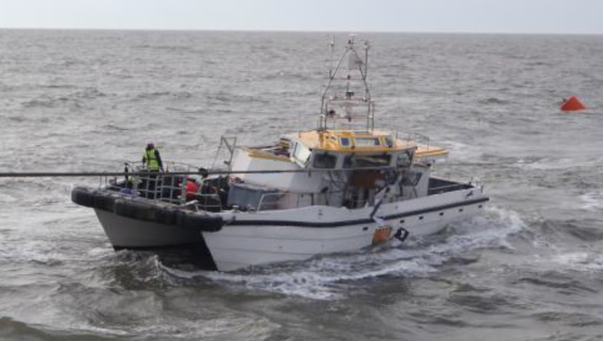Crew transfer vessel in collision with anchor wire
A member has reported an incident in which an offshore wind farm crew transfer vessel (CTV) collided with an anchor wire under tension. The incident occurred when the CTV approached the starboard side boat landing of a cable lay barge. Difficulty was encountered in positioning the vessel onto the boat landing, and at the same time, a pre-alarm on the port engine sounded (indicating overheating exhaust gasses). Owing to this alarm and the subsequent automatic intervention of the electronic engine management system, the CTV lost part of its propulsion power. At this point, the vessel was taken by the current towards the anchor wire. Due to sea conditions causing the CTV to move, the wire acted as a saw and caused significant damage to the wheelhouse. After this the vessel came loose of the anchor wire and the current took the CTV further away. There were no injuries.


During Our member’s investigation, the following points were noted:
- A similar incident had happened with the same CTV earlier in the year;
- Crew transfers are executed so often that they can be considered as a ‘routine’ activity (‘taxi’) leading to risks being overlooked and complacency setting in;
- Crew transfer is an important activity and should be formally risk assessed on each project since environmental conditions differ for each project;
- Reporting, communicating and follow-up of incidents and near misses is important since this incident would have been prevented had the previous incident been properly reported, correctly communicated and follow-up had been in place and adhered to.
Members may wish to refer to the following similar incidents:
- The following safety flashes refer to incidents involving the crew transfer vessels used in the offshore renewables industry:
- Crew transfer vessel trapped under a boat landing
- USCG Homeport Marine Safety Alert: Recent failures of dynamic positioning (DP) systems on MODUs, Wind farm service vessel in collision with wind turbine foundation
- Lost time injury (LTI): Crewman injured foot during offshore renewables mooring operation
- Near-miss: Strong sun glare contributes to heavy impact on boat landing, Near-miss incidents during personnel transfer to offshore renewable energy installations, Navigational near-miss in restricted visibility
- The following safety flashes refer to incidents where complacency was identified as a factor:
Safety Event
Published: 13 May 2014
Download: IMCA SF 07/14
IMCA Safety Flashes
Submit a Report
IMCA Safety Flashes summarise key safety matters and incidents, allowing lessons to be more easily learnt for the benefit of all. The effectiveness of the IMCA Safety Flash system depends on Members sharing information and so avoiding repeat incidents. Please consider adding safetyreports@imca-int.com to your internal distribution list for safety alerts or manually submitting information on incidents you consider may be relevant. All information is anonymised or sanitised, as appropriate.
IMCA’s store terms and conditions (https://www.imca-int.com/legal-notices/terms/) apply to all downloads from IMCA’s website, including this document.
IMCA makes every effort to ensure the accuracy and reliability of the data contained in the documents it publishes, but IMCA shall not be liable for any guidance and/or recommendation and/or statement herein contained. The information contained in this document does not fulfil or replace any individual’s or Member's legal, regulatory or other duties or obligations in respect of their operations. Individuals and Members remain solely responsible for the safe, lawful and proper conduct of their operations.
